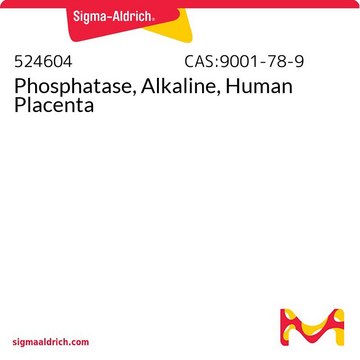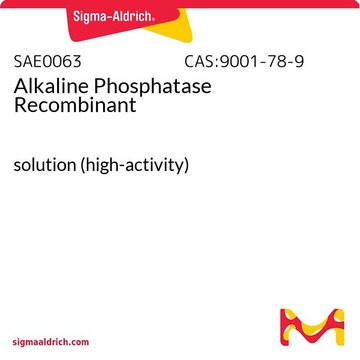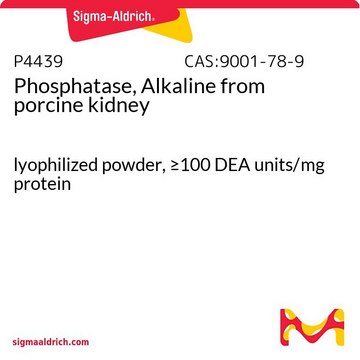SAE0111
Phosphatase, Alkaline from human placenta
≥10 units/mg solid (in glycine buffer)
Synonym(s):
Phosphatase, Alkaline from human placenta, Orthophosphoric-monoester phosphohydrolase (alkaline optimum)
Sign Into View Organizational & Contract Pricing
All Photos(1)
About This Item
CAS Number:
MDL number:
UNSPSC Code:
12352200
NACRES:
NA.54
Recommended Products
biological source
human placenta
specific activity
≥10 units/mg solid (in glycine buffer)
UniProt accession no.
storage temp.
−20°C
Gene Information
human ... ALPP(250)
Looking for similar products? Visit Product Comparison Guide
Application
Alkaline phosphatase is used for conjugation to antibodies and other proteins for ELISA, Western blotting, and histochemical detection. It is routinely used to dephosphorylate proteins and nucleic acids. It may be used for protein labeling when high sensitivity is required. Alkaline phosphatase may be also be used to dephosphorylate the 5′-termini of DNA or RNA to prevent self-ligation. DNA or RNA can also be tagged with radiolabeled phosphate (via T4 polynucleotide kinase) after dephosphorylation with alkaline phosphatase.
Biochem/physiol Actions
Alkaline phosphatase dephosphorylates proteins and nucleic acids. Human placental alkaline phosphatase (PLAP) has an unique residue, Glu-429. It is an allosteric enzyme that is uncompetitively inhibited by L-Phe, L-Trp, and L-Leu. PLAP is post-translationally modified. Phosphatidylinositol-specific phospholipase C may be involved in the release of PLAP. PLAP may have a role in cell division and may be involved in the transfer of maternal IgG to the fetus.
Unit Definition
One unit will hydrolyze 1.0 umole of P-Nitrophenyl Phosphate per minute at pH 10.4 at 37 Deg C.
Signal Word
Danger
Hazard Statements
Precautionary Statements
Hazard Classifications
Resp. Sens. 1
Storage Class Code
11 - Combustible Solids
WGK
WGK 1
Flash Point(F)
Not applicable
Flash Point(C)
Not applicable
Regulatory Information
常规特殊物品
Choose from one of the most recent versions:
Already Own This Product?
Find documentation for the products that you have recently purchased in the Document Library.
Our team of scientists has experience in all areas of research including Life Science, Material Science, Chemical Synthesis, Chromatography, Analytical and many others.
Contact Technical Service





